Metod Frlic: God with an Implant
Ivan Grohar Gallery
28 May – 13 July 2025
Curator: Anabel Černohorski
The humorously titled exhibition God with an Implant by the academy-trained sculptor Metod Frlic showcases a cross-section of the artist’s work created over the past fifteen years, with an emphasis on his most recent sculptural explorations. The first gallery room features a work from Frlic’s politically engaged series, created in 2018, that marked the previous decade of his oeuvre, and two examples of abstract “sculptural paintings” from 2022, in which Frlic explores optical effects on the surface of naturally dark stone. The second gallery room brings together five of the artist’s most recent sculptures created over the past three years and an example of portrait sculpture made in 2010. The thing these works have in common is the predominant use of stone and colour. Three of them depict different parts of the human body, while two others – more abstract ones – create an impression of tissues of organic origin. The title of the exhibition, which indirectly refers to plastic surgery, also emphasises the idea that nobody is perfect.
In terms of style, Metod Frlic’s work ranges from more or less realistic depictions of the visible world – the human body being a very common subject – to highly abstracted forms. The artist uses a wide range of materials: from stone, clay, plaster, wood and metal to synthetic substances, such as epoxy resin, or various plastic filaments used in 3D printing. In addition to the various ways he works the materials, the use of paint plays an increasingly important role, even in his works made of bronze; in fact, according to the artist himself, he has always been interested in painting.
Frlic worked on his politically engaged series in the period between 2014 and the early 2020s. The series is characterised by a diverse use of media and materials – it includes stand-alone sculptures, spatial installations, video, photography and found objects. This exhibition features the work titled What Europe Fears (2018), a spatial installation made of wood, iron and painted plaster – an enlarged chessboard filled with nothing but black-covered figures. Its creation was inspired by the (re)election of Erdoğan as President of Turkey in 2018 and the impact the votes of Turkish expats had on the outcome of the election. It is evident from this example that Frlic often explores current global and European issues that are often dealt with in the media. Although as part of this series, which he had worked on until recently, the artist consciously created provocative works with seemingly singular messages, these works are open to multiple different interpretations.
The first gallery room shows two works resembling small stone paintings – Vision 2069 and Vision 2071, painted in 2022, which are part of the artist’s series focusing on the exploration of optical effects. The artist has darkened selected areas without the use of paint, using only mechanical processes. This has resulted in distinct black fields that stand out from the grey, less-worked areas of the natural material, creating a sense of surface depth. Unlike the earlier works in this series, which date back to the early 2000s, the more recent depictions are no longer strictly geometric – the darker fields follow the structure of the stone in a more organic way.
An important part of Frlic’s oeuvre is portrait sculpture, including works in public spaces. Among the many portrait sculptures Frlic has created, one of the most notable ones is his bust of Ivan Tavčar at the tomb in Visoko, as well as the numerous sculptural portraits that make up the Alley of Prominent Citizens in Škofja Loka. This exhibition is the first time that the public has the opportunity to see a coloured plaster portrait of Janez Hafner (1950–2012) from 2010, which is in private possession. Hafner, a distinguished local painter and one of the founding members of the Škofja Loka Artists’ Association, is depicted in Frlic’s signature style. Frlic always aims to capture the individual’s special personal traits and visual characteristics, including those that may be omitted from representative depictions. This applies not only to the exhibited work, but also to those installed in public spaces.
Frlic’s latest production is exhibited in the second gallery room, additionally separated by a black curtain. Most of the displayed works are stone sculptures placed on pedestals. Theme-wise, they are linked by the artist’s interest in the human body on the one hand and an exploration of organic forms in dialogue with the medium on the other.
The former category includes the sculptures Humanism (2023), which shows a heart (and part of the brain) in the palm of a hand, and Scalpel (2023), which depicts a female torso surrounded by breast implants made of various materials. On top of the torso, there are also some other parts of the body, including a nose, which stands out most. The work is named after the bestselling book by a Slovenian surgeon, Dr Ahčan; the sculpture draws on the book, presenting some reconstructive and plastic (micro)surgery innovations. More specifically, it highlights innovative breast and nose reconstruction techniques (such as a 3D model of a nose, created on the forearm, which was transferred to the patient’s face with preserved vascularisation and innervation).
Also on view is the sculpture Love in the Time of AI (2024), which combines a representation of a brain and an unusual helmet with real motherboards inserted in it by the artist. This work prompts reflection on the relationship between technology and humans/the human body – a theme that can be traced even in the most abstract works exhibited in this part of the exhibition. For instance, Cyborg 4000 (2023) is a sculpture made of stone and painted with a translucent pink coating that resembles musculature; its title alludes to technological enhancements of the body. Another, more abstract, example is the sculpture Restless Insides (2025); form-wise, it is related to Cyborg 4000, however, it “mutates” into a completely hybrid entity. Here, associations to muscles and animal tissues are fused with plant ones. Something soft and fluid seems to be oozing from the inside of the “restless”, hard sculptural material – these liquid-like elements have been made by the sculptor using blue- and green-coloured epoxy resin. This particular work shows the artist’s interest in light effects – the largely translucent areas made of plastics transmit and refract light, and the dynamic surface results in a distinct play of light and shadow.
The exhibition God with an Implant highlights the central interest of Frlic’s recent sculptural explorations – the relationship between sculptural material and the human body. It alludes to the theme of plastic surgery and modern-day bodily improvements through science and technology – such as hip and other prostheses, pacemakers etc. –, thus raising the question of man’s “cybernetisation”. The term cyborg (cybernetic organism) usually refers to the fusion of technology and an individual with the aim of improving their physical or mental abilities. Today, however, the line between all things “natural” (i.e. biological) and “technological” is increasingly blurred. To conclude in a somewhat humorous way, one might say that cyborgs have existed among humans for a long time – the only question, however, is how and to what extent development (including advancements in AI) will transform the human species as such.
Metod Frlic
Metod Frlic (1965, Suša in Poljane Valley) graduated in sculpture from the Ljubljana Academy of Fine Arts in 1989 under Professor Lujo Vodopivec, who was also his postgraduate mentor in 1996. He received further professional training in Germany in 1995 and Japan in 2000. Since 2009, he has been a lecturer at the Department of Sculpture at the Academy of Fine Arts and Design in Ljubljana. He has participated in numerous sculpture symposia and art colonies in Slovenia and elsewhere, including Austria, Italy, Hungary, Croatia, China, the United Arab Emirates and Greece. His works have been showcased as part of numerous solo and group exhibitions both in his home country and abroad. He is known for his portrait sculptures and numerous public monuments in Slovenia and other countries. He has received more than fifteen awards and distinctions, including the 2025 Ivan Grohar Award. He works in Ljubljana and Malenski Vrh above Škofja Loka.
Accompanying programme
Wednesday, 4 June 2025, at 19:00: A guided tour of the exhibition with the artist and curator.
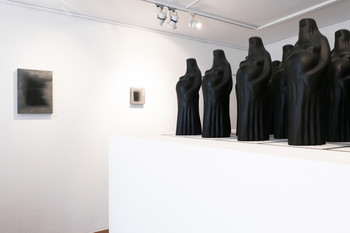
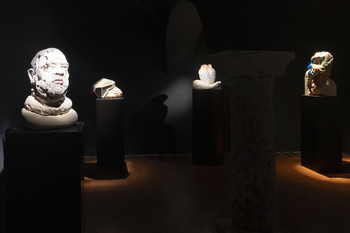
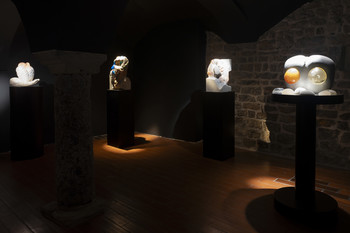
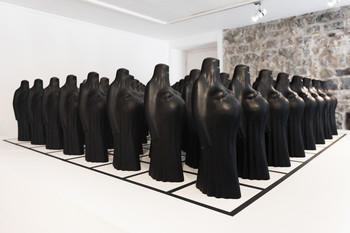
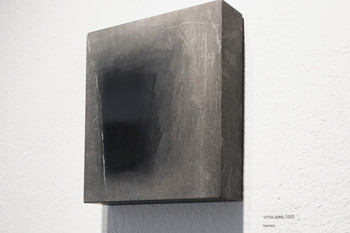
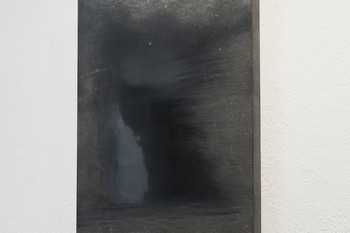
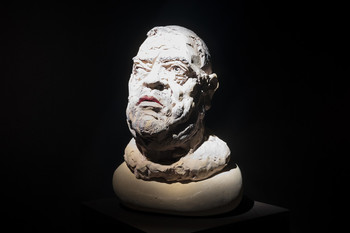
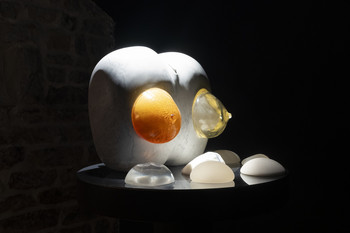
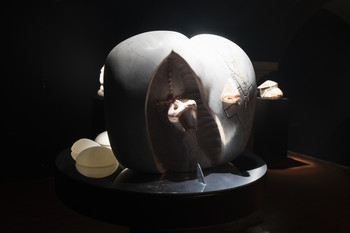
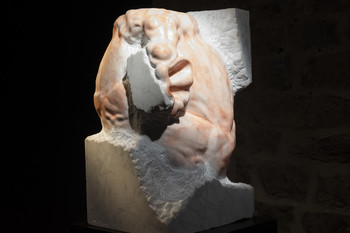
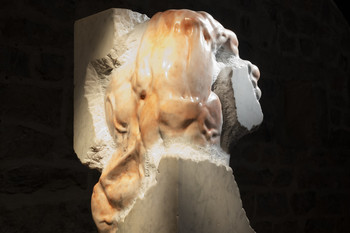
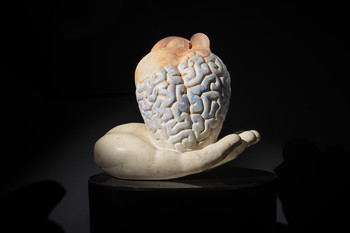
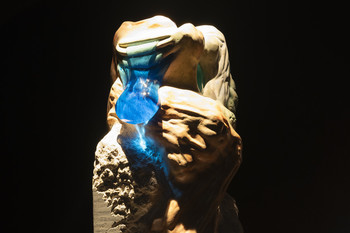
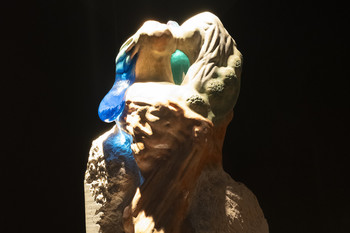
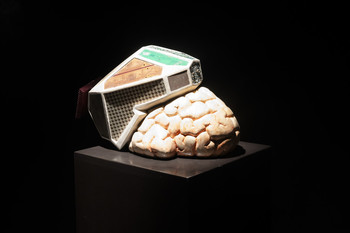
Download
- Metod Frlic: God with an Implant [PDF / 2.10 MB]
